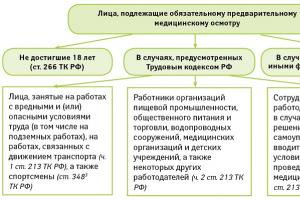Colleges, technical schools, schools
A college is an educational institution of secondary vocational education that implements educational programs for secondary vocational education in basic or advanced training. College education lasts from 3 years (in some specialties two years) to 4 years (in-depth training).
◑ Colleges, technical schools in Moscow
Modern colleges
Modern colleges and technical schools are very different from what they once were. First of all, these are modern educational institutions with a full set of necessary educational equipment and qualified teaching staff.
Many colleges have modern scientific laboratories, which are provided with everything necessary to carry out the educational process at a high level.
Plus, you can count on completing an internship at an enterprise where, having shown your best side, you have every chance of further work.
Most educational programs last 3 academic years. That is, students study in college instead of the tenth and eleventh grades of school and the first year of college. After which college graduates can easily enter the institute for the second year.
In college, the school curriculum is studied in one year of study, which means there are two years left for the university program.
The big advantage of modern special education is that simultaneously with general education, the student receives a profession, and as a rule, this is a sought-after profession that is in high demand in the labor market. This gives a great advantage over university graduates, who currently find it very difficult to find work in their specialty. And, probably, an important thing in a college or technical school is that it is much easier to get into it than into an institute.
Also, many institutions enthusiastically accept students after graduating from college, and even immediately into the second or third year. This practice is mainly used by universities, on the basis of which colleges are created. In order to attract as many students as possible, colleges and technical schools are simply obliged to keep up with the times, and for this reason, many colleges are opening such faculties as: designer, stylist, jeweler, accountant.
To summarize in a few words the advantages of colleges over universities are:
- Obtaining a sought-after specialty simultaneously with general education
- Almost 100 percent employment upon completion.
- The remuneration of a qualified specialist is often much higher than the remuneration of a university graduate.
◑ Colleges and technical schools in Moscow districts
| Colleges, technical schools in Moscow districts | |
|---|---|
| Central Administrative District (CAO) | Southern Administrative District (SAD) |
| Northern Administrative District (NAO) | South-Western Administrative District (SWAD) |
| North-Eastern Administrative District (NEAD) | Western Administrative District (JSC) |
| Eastern Administrative District (VAO) | North-Western Administrative District (NWAD) |
| South-Eastern Administrative District (SEAD) | Zelenograd administrative district (Zelenograd) |
| Moscow region | Directory of professions |
| Medical colleges and schools | |
| Colleges at universities | |
◑ Useful information
The most popular specialties in the labor market (TOP 50 professions)
What is the difference between “state” diplomas and “established” diplomas?
Many people don’t think twice about reading information on an educational institution’s website about what diploma a student will receive after completing their studies there, but this is EXTREMELY IMPORTANT! Before applying, be careful and keep in mind that the above diplomas are two big differences!
In Russia there are two types of secondary vocational education programs:
- basic level program
- advanced level program
You can master training programs at both levels in colleges. Technical schools offer secondary vocational education specialties only at the basic level.
Basic level program
Involves training in the necessary minimum knowledge in a specific specialty in accordance with established standards.
Duration of training for the basic level program full-time based on 11th grade ranges from 10 months to 2 years 10 months depending on the training profile. By full-time and correspondence forms based on 11 classes The duration of training is increased by 1 year. Based on 9 classes The duration of training ranges from 2 years 10 months to 3 years 10 months, depending on the specialty.
Advanced level program
Studying in advanced secondary vocational education specialties provides broader knowledge compared to the basic level in the same specialty. This program prepares mid-level specialists, just like the basic level program, but upon completion the graduate is awarded a higher qualification (“senior technician”), or the phrase “with advanced training” is added to the basic qualification.
A graduate who has undergone in-depth training receives a higher qualification or qualification with additional training in other areas. For example, a graduate of a specialty with basic training is awarded the qualification “Designer”, and with advanced training - “Designer, teacher”.
Duration of training for the advanced level program SPO increases by 1 year compared to the period of study under the basic level program.
In addition, the level of preparation may affect the length of study of an applicant with a vocational education diploma at a university. As you know, graduates of colleges and technical schools can study at universities using shortened (accelerated) training programs. If you have a diploma of secondary vocational education at a basic level, the period of study will be reduced by one year, if you have a diploma of secondary vocational education at an advanced level - by two years.
Every person sooner or later has to face the need to choose a profession. But sometimes it happens that a person does not want to go straight to university after school. Then his choice falls on receiving some kind of vocational education at technical schools or colleges. It is also possible that after completing nine grades, a teenager also wants to receive some kind of specialty. Then he goes to technical schools. Let's figure out what secondary vocational education is.
What is secondary vocational education?
Vocational education is a type that involves advanced training of students, adapted for a specific profession. In Soviet times, the main institutions that provided the opportunity to obtain secondary vocational education were technical schools. Now some of them have been renamed colleges.

At the same time, both technical schools and colleges can belong to a specific university, which can be entered immediately into the third year. Although this is not the case everywhere. But certain privileges do exist. For example, more advantageous positions in the competition for admission. But this depends directly on the university to which the technical school belongs.
How is it different from vocational school?

Many people are interested in what is the difference between a secondary educational institution and a vocational school? In principle, now almost nothing is said about the latter. Some vocational schools were also renamed technical schools and colleges. In general, now there are almost no vocational schools left in the form in which we are used to seeing them before. But there are colleges and technical schools that allow you to get a secondary technical education.
Differences between SPO and NGO

Secondary technical education differs from primary education in many factors. Let's list only the main ones. First of all, SVE prepares mid-level specialists. They also provide in-depth study of issues related to obtaining a profession. This happens on the basis of complete secondary, basic education, or after graduating from an NPO.
Those people who have primary technical education receive secondary education based on what already exists. The training program is shortened so that there are no repetitions, and new things are taught right away. In this way, you can improve your skills. Also, the point that distinguishes secondary vocational technical education from NGOs is that the former can also be obtained at a higher educational institution, and institutions that provide secondary education can, if they have a license, provide elementary-type educational programs.
Examples of specialties characterizing secondary technical education
In fact, if you want to get acquainted and learn all the professions included in the secondary technical class, then it still won’t work. In principle, secondary education can be obtained for a huge number of specialties, even those that many receive at universities. Naturally, the quality will be much worse. Still, there is a difference between secondary technical and higher education. Examples of specialties include: marketing, management, banking, electrical engineering, energy supply and a number of other specialties.
What about distance learning?
Some people believe that there will be problems with obtaining distance education. But this is absolutely not true. Students are given a wide opportunity to receive distance education. According to the standards of the secondary technical education system, it is possible to receive not only correspondence education, in the classical sense of the word, but also distance education, when learning takes place via the Internet. However, one point should not be forgotten.
If a person wants to study by correspondence or distance learning, then he needs to finish school, and nothing else. So it is best to receive secondary technical education after school. At the same time, the effectiveness of training, despite what they say, is far from deteriorating. In particular, this happens because students need to undergo internships at enterprises related to their chosen profession.
There, skills and the necessary practical knowledge are developed, which in the future will help you feel great when performing your duties. It is possible to obtain secondary technical education by correspondence. But there will be no socialization. You can simply deprive yourself of communication with people. Think about it, do you need it?
conclusions
We figured out the main differences between vocational schools and colleges and technical schools. Many people are interested in how long training takes. Each establishment is different. In some, you need to spend four years to master the specialty. In others, either the course is more intensive or the specialty is easier. Therefore, you can master the specialty in two years.
But usually the average option is three years. Also, you should not enroll in secondary schools if you want to avoid joining the army. Studying in colleges and technical schools does not exempt you from military duty. You need to think about whether it is worth going to get a secondary technical education. Specialties of a similar type can be obtained at universities. But it's up to you to decide.
Sale of original diplomas of secondary vocational and special education from GOZNAK. Delivery throughout the Russian Federation. No prepayment. Price from 14,000 rub. Call the numbers on the website!
Diplomas of secondary specialized education
Lack of education is a big obstacle in finding a job. But you don't have to have a college degree to start a career in a particular field. For example, if you are interested in photography and take good pictures, or are well versed in electrical engineering and can repair electrical equipment, or are a specialist in construction, it is enough to simply purchase a document on completion of secondary vocational education. It involves studying at one of the educational institutions: a technical school, a vocational school (both during the USSR and after the collapse of the Soviet Union) or a college. This can be done in our company, which has been helping its clients start a new professional life for more than 20 years!
Three tips on how to properly buy a diploma of secondary specialized/vocational education?
First, decide on a college or technical school.
It often happens that you know what specialty you want, but have not decided on an educational institution. It's not a problem! Our managers always have a database at hand, and in five minutes they will select you a list of the best options. If you also have doubts about choosing a specialty, we are ready to listen to your wishes in the specialty and advise on the most in-demand and highly paid professions.
Secondly, in order to buy the right document on completion of secondary specialized education, decide what the period of your study will be.
This is important information, since the GOZNAK forms that we work with may differ depending on the year of graduation from a technical school or college. It is the year of graduation that is important. Let's give a simple example: if you want to be a graduate of 2013, then the document will be made on forms relevant for 2011-2013. Accordingly, with a later release, the forms will be different.
Thirdly, it is recommended to take a responsible approach to choosing a specialty.
If you decide to purchase a diploma of secondary specialized or vocational education. It should match your skills. And, if you do not yet have work experience in any specialty, then it is recommended to choose something from the list of professions in demand by employers. For example, at the moment it is quite easy to find a job as a designer, photographer, or advertising specialist. Everything related to the construction industry is also in demand.








